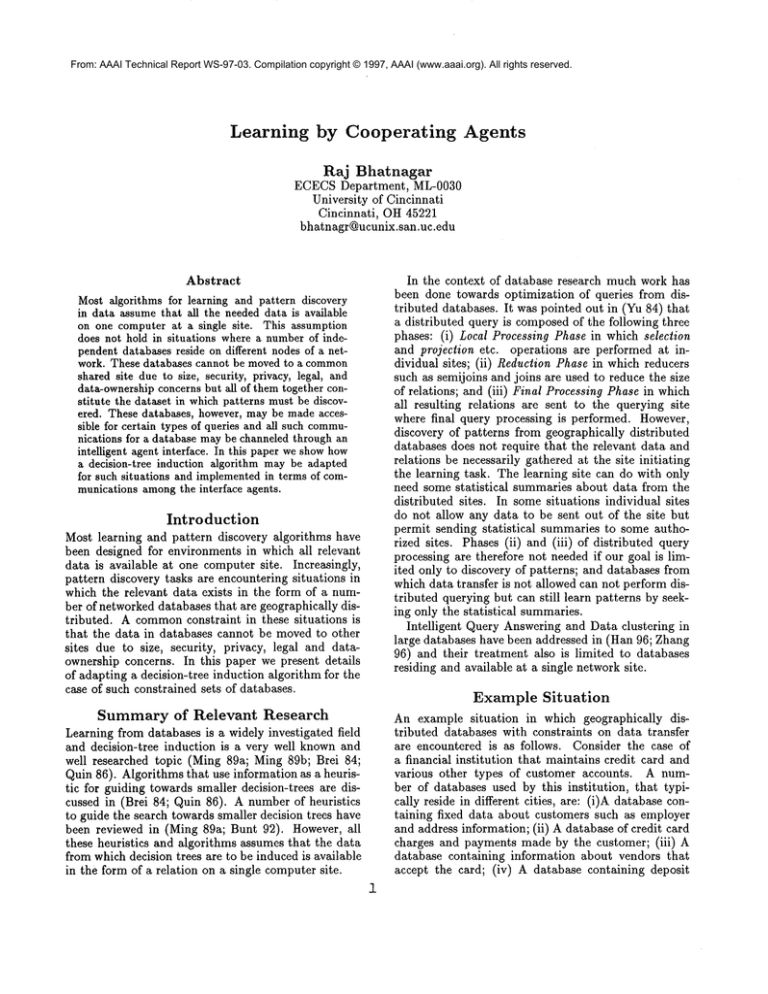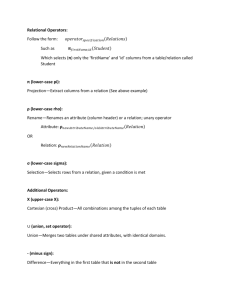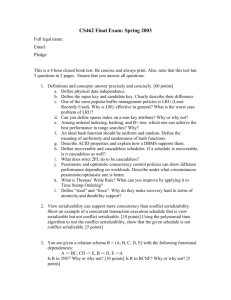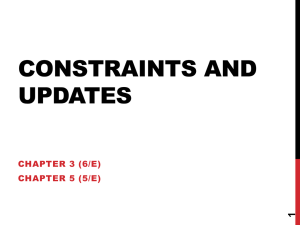
From: AAAI Technical Report WS-97-03. Compilation copyright © 1997, AAAI (www.aaai.org). All rights reserved.
Learning
by Cooperating
Agents
Raj Bhatnagar
ECECS Department, ML-0030
University of Cincinnati
Cincinnati, OH45221
bhatnagr@ucunix.san.uc.edu
Abstract
In the context of database research much work has
been done towards optimization of queries from distributed databases. It was pointed out in (Yu 84) that
a distributed query is composedof the following three
phases: (i) Local Processing Phase in which selection
and projection etc. operations are performed at individual sites; (ii) Reduction Phase in which reducers
such as semijoins and joins are used to reduce the size
of relations; and (iii) Final Processing Phase in which
all resulting relations are sent to the querying site
where final query processing is performed. However,
discovery of patterns from geographically distributed
databases does not require that the relevant data and
relations be necessarily gathered at the site initiating
the learning task. The learning site can do with only
need some statistical
summaries about data from the
distributed sites. In some situations individual sites
do not allow any data to be sent out of the site but
permit sending statistical
summaries to some authorized sites. Phases (ii) and (iii) of distributed query
processing are therefore not needed if our goal is limited only to discovery of patterns; and databases from
which data transfer is not allowed can not perform distributed querying but can still learn patterns by seeking only the statistical summaries.
Intelligent Query Answering and Data clustering in
large databases have been addressed in (Han 96; Zhang
96) and their treatment also is limited to databases
residing and available at a single networksite.
Most algorithms for learning and pattern discovery
in data assumethat all the needed data is available
on one computer at a single site. This assumption
does not hold in situations where a numberof independent databases reside on different nodes of a network. These databases cannot be movedto a common
sharedsite due to size, security, privacy, legal, and
data-ownershipconcerns but all of them together constitute the dataset in which patterns must be discovered. These databases, however, maybe made accessible for certain types of queries and all such communications for a database maybe channeled through an
intelligent agent interface. In this paper we showhow
a decision-tree induction algorithm maybe adapted
for such situations and implementedin terms of communications amongthe interface agents.
Introduction
Most learning and pattern discovery algorithms have
been designed for environments in which all relevant
data is available at one computer site. Increasingly,
pattern discovery tasks are encountering situations in
which the relevant data exists in the form of a number of networked databases that are geographically distributed. A commonconstraint in these situations is
that the data in databases cannot be movedto other
sites due to size, security, privacy, legal and dataownership concerns. In this paper we present details
of adapting a decision-tree induction algorithm for the
case of such constrained sets of databases.
Example
Summary of Relevant
Research
Learning from databases is a widely investigated field
and decision-tree induction is a very well knownand
well researched topic (Ming 89a; Ming 89b; Brei 84;
Quin 86). Algorithms that use information as a heuristic for guiding towards smaller decision-trees are discussed in (Brei 84; Quin 86). A number of heuristics
to guide the search towards smaller decision trees have
been reviewed in (Ming 89a; Bunt 92). However, all
these heuristics and algorithms assumes that the data
from which decision trees are to be induced is available
in the form of a relation on a single computersite.
Situation
An example situation in which geographically distributed databases with constraints on data transfer
are encountered is as follows. Consider the case of
a financial institution that maintains credit card and
various other types of customer accounts. A number of databases used by this institution, that typically reside in different cities, are: (i)A database containing fixed data about customers such as employer
and address information; (ii) A database of credit card
charges and payments made by the customer; (iii)
database containing information about vendors that
accept the card; (iv) A database containing deposit
1
and withdrawal transactions; and (v) A database containing credit-rating information about customers. A
knowledgediscovery task mayrequire discovery of interesting patterns in the dataset that is formed by considering all these databases together.
A number of other examples from military and civilian domains exist in which data from various sources
must be used without moving it over the networks and
compromisingits security.
Cooperation among such independent and geographically distributed databases is typically governed by a
number of constraints.
Constraints
on Knowledge
Sources
The most commonrestrictions
in distributed knowledge environments and the reasons for their existence
are as follows:
Immobility of Databases: The actual data from
a database maynot be transported to any other site.
This restriction mayarise due to any of the following: the database size is too large; security reasons
demand that data not be placed on networks, dataownership and privacy issues prevent its owners from
sharing the data with others. However, these sites
maybe willing to share summariesof data with other
authorized sites.
Update Protection:
A database may not permit
an agent outside its ownsite to update its data due
to security and data-integrity considerations.
One-Agent interface:
At each database site only
one software agent may be allowed to coordinate all
flow of information into and out of the database.
This maybe required to guarantee the integrity and
security of the database.
Availability: All databases may not be available for
cooperation with other databases at all times. For
example, if one credit rating company’s database
is unavailable at any time, we may use another
database with similar information. At the time a
learning task is to be performed we must check and
determine the availability of other databases for cooperation.
Abstraction
of Knowledge
Environment
The situation of n knowledgesources located at n different sites and represented by their respective agents
can be represented as shown in Figure-1 below. A dbi
represents a knowledgesource present at the i th site.
Associated with each knowledge source is an Interface Agent that acts as the only interface for all communications between the knowledge source and other
agents in the outside world. This agent is shown by
Ais associated with the databases. Any cooperation
amongthe knowledge sources is initiated, negotiated,
and transacted by the agents communicating over the
network.
In an abstract sense each knowledge source can be
viewed as containing tuples of an m-attribute relation.
The actual underlying data may not be in the form
of a relation but the interface agent can create a simulated view in which the external world can see each
knowledge source as a database relation. This kind
of interface is possible even for databases containing
maps and images but the relation-like views that may
be simulated may be restricted in terms of the nature
of attributes contained in them.
Silo-2
x2 x4 x7 .,.
A2
Site-3
x3 x7 xg...
A3
=3x%.
Figure 1: Databases
The set of attributes contained in database dbi is
represented by Xi. For any pair of databases dbi and
dbj the corresponding sets Xi and Xj may have a set of
shared attributes given by Sij. That is, Sij -- Xi AXj ..
For the present discussion we assume that all attributes are nominal-valued. In a later section of this
paper we separately address the handling of continuous
valued attributes.
The dataset D using which a decision tree is to be
constructed is that which is formed by a Join operation
performed on all the relations dbl...db,~ identified as
relevant for the learning task.
Consequences
of Constraints
The tuple space (dataset) from which the decision tree
is to be induced is only implicitly specified in terms
of the JOin or the cross product of the component
databases. That is, this space can be made explicit
by performing a cross-product or a JOIN-operation
on the individual component databases. However, due
to the constraints on the movementof data such an
explicit dataset can not be created.
Therefore, our pattern discovery algorithms must
work with the implicitly specified tuple space. This
restriction maynot, at first, appear drastic but after
some analysis turns out to have severe implications.
Any pattern discovery and inference algorithm which
demands that explicit data tuples be presented to it
can not work in the distributed
environments. For
example, neural network training requires that each
training tuple be presented to the network. But in
the distributed knowledgesources case each tuple has
its components residing at individual database sites
and the tuple can not be assembled and made explicit.
Therefore, the neural network training algorithms are
not applicable in the distributed environments.
~
3. The agent that initiates the discovery task can send
requests to various sites for statistical
summaries
about their respective dls. Actual data tuples are
not allowed to be exchanged amongthe agents.
4. The initiating
agent can compose responses from
other agents and construct the descriptions of decision trees.
Webriefly outline here some aspects of the decision
tree induction algorithm even though it is a well known
algorithm. Wedo so to facilitate
easy reference and
comparison with the adapted version of the algorithm.
Explicit Data
Computation
with explicitly known
data
Aggregation
I
~
Decision-Tree
Induction
Algorithm
Various tree-induction algorithms including ID3 start
by considering the complete dataset D as residing at
the root of the tree and then repeating the following
steps until somespecified percentage of tuples at all
leaf nodes belong to some unique class (Value of the
Target-Attribute).
1. Pick one such dataset at a leaf node of the partially constructed tree whose tuples belong to different classes. (By dataset here we are referring to
any set of tuples belonging to a node of the decision
tree.)
2. Select an attribute aj having m distinct values:
ajl, aj2 . . .aj,~.
3. Split D into m distinct partitions such that the ]¢th
partition contains only those tuples for which aj =
ajk.
are added to the tree
4. The m distinct partitions
as child datasets of the partitioned parent dataset.
These child nodes reside at the end of m branches
emanating from the parent node.
It is desirable to keep the height of the induced decision tree as small as possible. A heuristic that is
used to keep the height on the smaller side selects that
attribute ai in Step-2 which minimizes the average informational entropy of the partitions that are formed
in step-3. The value of this average entropy can be
computed as:
m Nb ~x--~
Nbc,
Nbc~
Cross-Product
Computation
Decompostion~
Computation
withImplicitlyspecified data
Figure 2: Computations in Explicit vs. Implicit Data
Spaces
Only those computations can be performed in the
implicit data space that can be decomposedinto parts;
these parts performed at individual sites; and then the
results transmitted and composedat the initiating site.
The decomposition and aggregation/composition operations for any particular set of databases are strongly
influenced by the sets of shared attributes Sij because all dependences amongattributes are mediated
through the set shared attributes.
To facilitate handling of the implicitly defined tuples
of D we define a set S that is the union of all such
intersection sets. That is,
S=UI,j ,i#j
S/j
(1)
The set Sij is the same intersection set as defined
above. The set S contains all those attributes that
occur in more than one di. Wealso define a new relation Shareds containing all the attributes in set S. The
tuples in Shareds are made explicit by enumerating all
possible combinations of various values for attributes
in set S.
The roles sought to be performed by the interface
agents associated with database sites are the following:
1. A knowledge discovery task can be initiated by an
agent that is located at any one of the n database
sites, or possibly any other authorized site.
E=
×
--~
(2)
C
No
~ vO
where Nb is the numberof tuples in branch b, N~ is the
total numberof tuples in all branches, c is the number
of possible classes (the values the target attribute can
possess), and Nb~is the number of tuples in branch b
belonging to class c. The attribute that minimizes the
average entropy for the resulting partitions is chosen.
2. All the X~s (attribute sets) are knownto each interface agent and as a consequence, the relation Shareds
is also knownto every agent capable of initiating the
decision-tree induction task. With this information,
the agent can decomposethe tree induction task into
suitable queries for agents at other database sites.
Adaptation
for Implicit
Tuple Space
The following describes one possible adaptation of
the tree induction algorithm for distributed databases.
The details and complexity analysis have been described in (Bhat 97).
3
The tree induction algorithm outlined in the preceding section requires an explicit set of tuples at each
node of the tree. This set is used for the following
operations:
1. Computationof entropy after partitioning a dataset.
2. Testing to determine if all tuples in a dataset belong
to the same class.
In case of the constrained distributed databases an explicitly stated set of tuples is not available. Each step
of the induction algorithm must adapt itself to work
with the implicitly specified set of tuples.
Characterization
of a set of tuples:
Whena dataset is known explicitly it can be stored
as a table in computer memory.After repeated partitionings, smaller datasets can be represented by storing their identity numbers along with each tuple as an
additional column of the relation.
Whenthe dataset is only implicitly specified there
does not exist any facility to store identities of partitions to which individual tuples belong. Description of
every partition or cluster must also be implicit. For
the case of decision trees the conjunction of tests performed along a path is the implicit description of the
dataset at the end of that path. Clustering and pattern
discovery algorithms that rely on marking each tuple
with their cluster-id as they progress will not be able
to work in environments of implicitly specified tuples.
Selecting
the Test Attribute:
In step 2 of the algorithm we choose an attribute and
use it to partition the selected parent dataset into its
children datasets. The attribute that minimizes the
average informational entropy is considered the most
promising one and is selected. The expression for entropy computation requires the values of the following
counts from the parent dataset:
1. Nt;
2. one Nb for each child branch; and
3. one Nbc for each class for each child branch.
Whenthe tuples are explicitly stated and stored in a
table these counts can easily be obtained. For the case
of implicitly stated set of tuples we have decomposed
the counting process in such a way that each decomposed part can be shipped to an individual database
site and the responses composed to reconstruct the
counts. The decomposition for obtaining the count Nt
is as follows:
n
-- EEZ(II(N(d’)s
J*k
Js2
J81
(3)
i:1
where
Sub=[Sl
= SIj.I],
[$2=
[Sk=
Skj.k ]. In this expression S1, $2,... Sk are the k members of set S defined by expression 1; Jsl, Js2,...Jsk
are the numbers of possible discrete values that can
4
be assigned to attributes S1, S2,...Sk respectively;
and Sil, Si2,... Sijs~ are all the values that can be assigned to attribute Si. The value n is the number of
database sites (dis) to be considered, and (N(di)sub)
is the count in relation di of those tuples that satisfy
the conditions Sub.
It can be seen that the expression for Art is in the
sum-of-products form. Each product term takes in the
counts of tuples satisfying condition Sub in each dl and
produces the number of distinct tuples that would be
contributed to the implicit Join of all dis. Also, each
condition Sub for the entire summation in the above
expression corresponds to a tuple of relation Shareds
described earlier. The summationin the expression is
over all the tuples of relation Shareds.
This expression, therefore, simulates the effect of a
Join operation on all the n sites to compute the count
of tuples satisfying Sub that would exist in D.
A very desirable aspect of the particular decomposition of Nt given above is that each product term
(N’(Tt)8,,b) can also be easily translated into an SQL
query of the form:
Select count (*) where sub ANDpath to dataset
The learning agent can ship the queries to the agents at
other relevant sites and composethe responses according to the expression for Art. For each tuple in relation
Shareds the agent will have to send the queries to each
of the other n database sites. The responses can then
be multiplied to obtain a product-value for a tuple, and
the product-values for all the tuples of Shareds can be
summedto obtain the value Art.
The decompositions for the counts Nb and Nbc are
similar to that for Art. The expressions are stated as
follows:
J,2
J,1
t----I
whereSUB=- [SI--SIj,I],[$2--S2j,=]
...,[Sk=
Skj,k], [B = Bj,]
The expression for Nb differs from that for Art by
containing an additional summationover the partitioning attribute B and the corresponding addition to the
condition part of the product term.
n
here
= E E... E
JB J,k
Y,2
J,1 t=l
(5)
SUB = [SI = Slz.,],[S2 = S2j,2]...,[Sk=
skj. ], [B=Bj.],IV=Cj]
The expression for Nbc differs from that for Nb by
containing an additional summationover the target attribute C and the corresponding addition to the condition part of the product term.
The counts Art, Nb, and Nbc can be composed by
obtaining responses from individual databases in the
mannerdescribed above and the the entropy value for
each proposed partitioning can be determined.
Splitting
A Dataset:
After deciding to partition a dataset into its children
datasets (Step-3) the learning agent needs only maintain the decision tree constructed so far. At the learning site a marking can be maintained for each leaf node
indicating whether all its tuples belong to only one or
more classes. This can be determined by examining
various Nb~counts at the time of creating the children
datasets.
Continuous-Valued Attributes
For the nominal-valued attributes we know the set of
possible values an attribute can take and therefore also
knowthe potential set of tests that maybe performed
at each node of the decision tree by an attribute. The
situation for continuous-valued attributes is somewhat
more difficult.
In most tree induction algorithms a
threshold value is chosen as the test and tuples lying
on the two sides of this threshold belong to two different partitions at the child nodes of the tree. The set of
candidates for the threshold values for a continuousvalued attribute may be large. An efficient system
for determining the candidates has been described in
(Fayy 92). According to this system the continuousvalued variable is partitioned into sectors such that
each sector corresponds to only one class (value of the
target attribute). Figure-3 given below shows the various ranges for a continuous valued attribute A, the
unique classes belonging to the tuples falling in each
range, and the resulting set of candidate threshold values.
TI
I’2
I Cl I
2"3 T4
C2
flCl
"1"5.....
C3
llll
CI C2 C1
Incrcslngvalue of A
C2
I-
CI, C2.. arc different classes
to the learning agent, may be determined by enquiring the minimumand maximumvalues in all those
databases in which A exists.
2. Quantize the range for A into an arbitrary number
of bins of equal width.
3. Add attribute A and the target attribute to the set
S of shared attributes.
4. Construct the tuples in the relation Shareds by taking each bin as one possible value for attribute A.
5. Determine the count of all tuples in the implicit
dataset corresponding to each tuple of the relation
Shareds.
6. From the counts obtained construct a histogram by
accumulating counts for each range bin of the attribute A. Also keep an account of the classes for
tuples belonging to each range bin. This can be done
because the target attribute was included in the set
S of shared attributes.
7. If all tuples in a range bin belong to the same class
we call it a pure bin. Adjust the boundaries of the
range bins as stated below until all bins are pure or
pure to an extent, say, 98
(a) If two adjoining bins are pure and have the same
class then mergethese bins into one.
(b) A range bin that is not pure is split into two and
the frequencies determined as described above for
the smaller bins.
8. The range bins’ boundaries are the candidate threshold values.
The above method determines the candidate threshold values without transferring the tuples of data from
one site to the other. It seeks from the other sites the
count of tuples satisfying certain conditions. Having
determined these thresholds the tree induction algorithm can continue in a way similar to that for nominalvalued attributes.
Efficient
Agent Implementations:
The decomposition described above can be efficiently
implemented and the number of messages that need
to be exchanged among agents can be greatly reduced.
The counts that need to be obtained from each site for
each dataset partitioning are the Nbcvalues for all possible combinations. At the host site these can be appropriately summedup to generate the needed Nb and
Nt values. An alternate implementation strategy is to
have an application program that travels to each site
and accumulates all the needed summaries and then
moves to the next database site.
Figure 3: Determining Candidate Threshold Values
testing only for these candidate values is muchmore
efficient than testing for all possible threshold values
in the range of the attribute’s values.
Whenall the tuples are stored in one table the above
set of candidate threshold values may be obtained by
sorting all the tuples according to the continuous valued attribute and then sequentially scanning all the
tuples to determine the break points at which class
of the tuple changes from one to the other. For determining these break points for a continuous-valued
attribute A in the implicit data space we perform the
following steps:
Continuing Research
The research summarized above is currently being extended by us along a number of different directions.
The main directions and the preliminary results are as
follows:
1. Find the minimum and the maximumvalues taken
by the the attribute A. This range, if not known
5
Complexity Analysis:
A number of cost models have been applied to compare the computational cost of decomposedand single-site versions
of tree induction algorithm. It turns out that the
number of messages that needs to be exchanged
amongagents increases exponentially with the number of attributes that are shared amongthe various
databases. Weare examining the complexity issues
for continuous variables.
Other Learning Algorithms:
We are examining
the decomposedversions for inducing Bayesian classifiers. These results should be available by June
1997. All algorithms that must either present explicit tuples or put markings on individual tuples
can not be adapted for above mentioned environments. This includes most neural-net training algorithms and incremental learning algorithms. Weare
examining other learning algorithms and classifiers
for their decomposability.
Conclusion
In this paper we have considered the case of inducing decision trees by a set of cooperating agents. The
agents transmit only statistical summariesto other authorized agents and know which summaries should be
sought at each level of decision tree induction. Wehave
demonstrated the adaptability of an informational entropy driven decision tree induction algorithm for implementation by such agents. A heuristic for handling
continuous-valued attributes has also been shownto be
adaptable for such situations.
References
Bhatnagar, R. and Srinivasan, S. Discovering Patterns in Distributed Databases, Proceedings of the
AAAI-1997.
Breiman, L., Friedman, J. H., Olshen, R. A., and
Stone, C. J. 1984. Classification and Regression Trees,
Belmont, CA: Wadsworth.
Buntine, W., and Niblett, T. 1992. A further comparison of splitting rules for decision-tree induction.
MachineLearning, vol. 8, pp.75-86.
Fayyad, U. M., Irani, K. B. On the Handling of
Continuous-Valued Attributes in Decision Tree Generation MachineLearning, vol. 8, pp 87-102, 1992.
Han J., Huang, Y, Cercone, N., and Fu, Y. 1996. Intelligent
Query Answering by Knowledge Discovery
Techniques. IEEE Transactions on Knowledge and
Data Engineering, vol. 8. nO. 3, pp 373-390.
Mingers, J. 1989. An empirical comparison of selection measures for decision-tree induction. Machine
Learning, vol. 3, pp 319-342.
Mingers, J. 1989. An empirical comparison of pruning
methods for decision-tree induction. Machine Learning, vol. 4, pp 227-243.
Quinlan, J. R. 1986. Induction of Decision Trees, Machine Learning, vol 1, pp 81-106.
Yu, C, Ozsoyoglu, Z. M., and Kam, K. 1984. Optimization of Distributed Tree Queries, J, Computer
System Science, vol. 29. no.3 pp 409-445.
Wang, C., Chen, M., 1996. On the Complexity of Distributed Query Optimization. IEEE Transactions on
Knowledge and Data Engineering, vol. 8, no. 4, pp
650-662.
Zhang, T., Ramakrishnan, R., Livny, M. 1996. Proceedings of SIGMOD
96, 6/96, pp 103-114.







